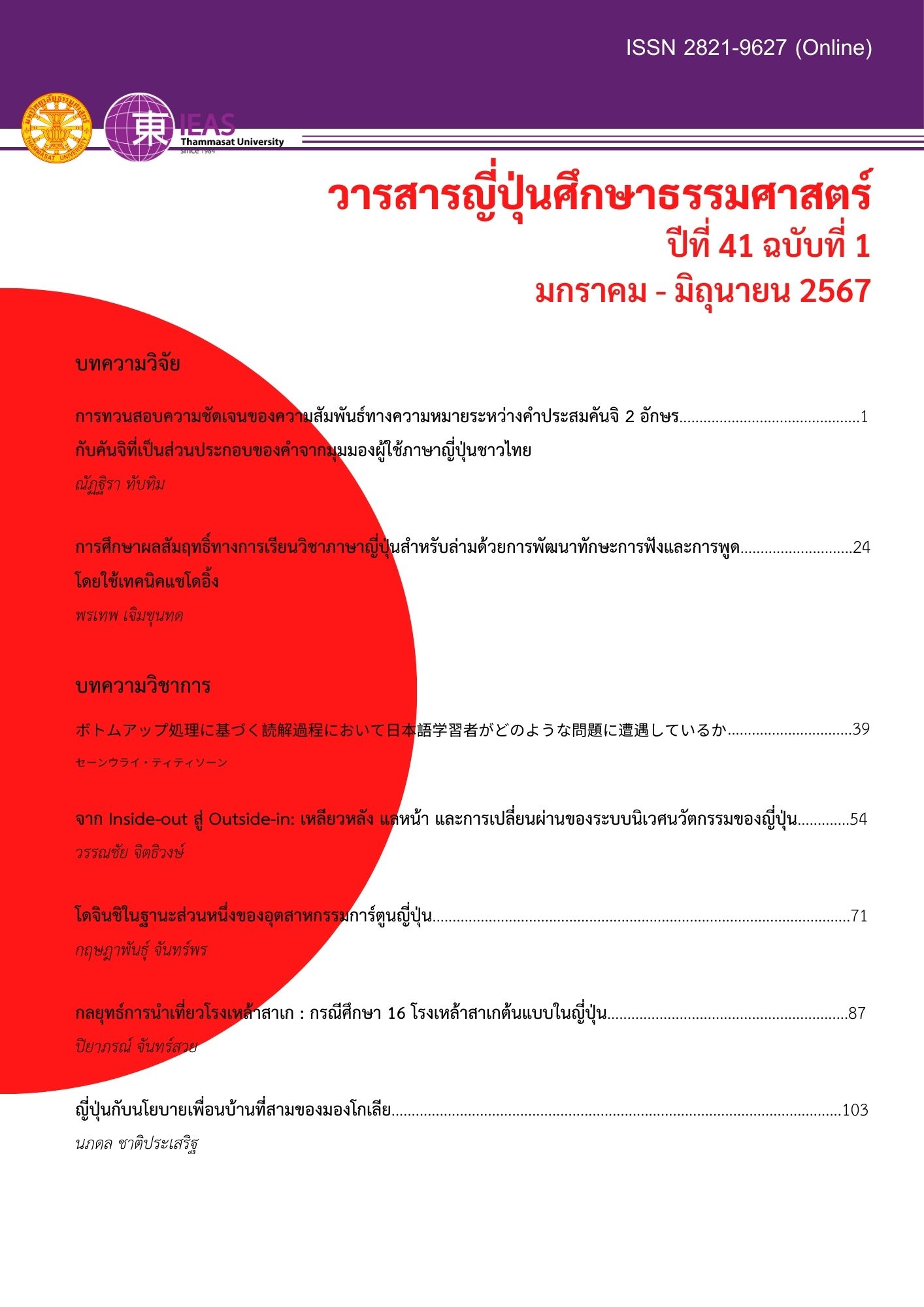โดจินชิในฐานะส่วนหนึ่งของอุตสาหกรรมการ์ตูนญี่ปุ่น
คำสำคัญ:
โดจินชิ, การ์ตูนญี่ปุ่น, สื่อบันเทิงบทคัดย่อ
บทความนี้มีวัตถุประสงค์เพื่อศึกษาข้อมูลเกี่ยวกับโดจินชิ ซึ่งเป็นส่วนหนึ่งของอุตสาหกรรมสื่อบันเทิงของประเทศญี่ปุ่น และปัจจัยที่ทำให้โดจินชิของญี่ปุ่นได้รับความนิยมอย่างแพร่หลาย โดยศึกษาจากเอกสารทางวิชาการที่เกี่ยวข้องกับโดจินชิ สื่อสังคมออนไลน์ และผลงานโดจินชิ ผลจากการศึกษาพบว่า โดจินชิเป็นผลงานที่ผู้สร้างทำขึ้นเองโดยไม่ได้ผ่านกระบวนผลิตร่วมกับสำนักพิมพ์ โดจินชิแบ่งออกเป็น 2 ประเภท คือ โดจินชิออริจินัล และโดจินชิดัดแปลงซึ่งโดจินชิประเภทนี้ถือเป็นการละเมิดลิขสิทธิ์ แต่กลับสามารถจำหน่ายได้อย่างกว้างขวางทั้งในประเทศญี่ปุ่นและในต่างประเทศ และมีนักเขียนโดจินชิดัดแปลงเพียงส่วนน้อยที่ถูกดำเนินคดี ปรากฏการณ์นี้เกิดขึ้นเพราะการได้ประโยชน์ร่วมกันระหว่างเจ้าของลิขสิทธิ์และผู้เขียนโดจินชิและความไม่คุ้มค่าของการดำเนินคดีทางกฎหมาย
Downloads
เอกสารอ้างอิง
ดรีม เอกซ์เพรส (เดกซ์). (2566, พฤษภาคม 11). เจ้าของสิทธิ์ จิบิมารุโกะ ออกจดหมายเตือนผู้วาดโดจินชิที่ไม่เหมาะสม. Dexclub.com. https://news.dexclub.com/artist-apologizes-deletes-chibi-maruko-chan-dojinshi-of-maruko-as-drug-addict/
เฟิร์ส เพจ โปร. (2566). การ์ตูน ประกาศให้โลกรู้ว่าบ้านอิมะอิซุมิเป็นแหล่งมั่วสุมของสาวแกลไปซะแล้ว เล่ม 1. https://www.firstpagepro.com/product/449/การ์ตูน-ประกาศให้โลกรู้ว่าบ้านอิมะอิซุมิเป็นแหล่งมั่วสุมของสาวแกลไปซะแล้ว-เล่ม-1
รื่นฤทัย สัจจพันธุ์. (2559). แฟนฟิก: วรรณกรรมเลียนแบบเพื่อยกย่องหรือย่ำยีงานต้นแบบ?. วารสารอักษรศาสตร์ มหาวิทยาลัยศิลปากร, 38(1), 9–50.
วิมลณัฐ หวังสิทธิกุล. (2560). BL กับ มุมมองเพศสภาวะ (Gender): ภาพสะท้อนผ่านสื่อ ท่ามกลางความเปลี่ยนแปลงในบริบทสังคมญี่ปุ่น. วารสารวิชาการมหาวิทยาลัยอีสเทิร์นเอเชีย ฉบับสังคมศาสตร์และมนุษยศาสตร์, 7(1), 70-77.
ศิรินนา วอนเก่าน้อย. (2565). แฟนศึกษาสู่พฤติกรรมสารสนเทศของแฟน. วารสารห้องสมุด สมาคมห้องสมุดแห่งประเทศไทยฯ, 66(1), 37–51.
ศุภาวรรณ คงสุวรรณ์. (2561, ธันวาคม 18). นิยายวาย : กระแสนิยม และกระจกสะท้อนสังคมที่ ‘ไร้เดียงสาทางเพศ’. The 101.World. https://www.the101.world/what-yaoi-tell-us/
Animate. (2023). 【同人誌】今日も厨は騒がしい4. https://www.animate-onlineshop.jp/pn/【同人誌】今日も厨は騒がし%204/pd/2342884/
Animate (2023). 【同人誌】【専売】いつまでたっても【特典付】. https://www.animate-onlineshop.jp/pn/【同人誌】【専売】いつまでたっても【特典付】/pd/2260016/
B-Ikeguchi, C. (2018). The Otaku culture and its cultural ramifications. Journalism and mass communication, 8(5), 246-259.
book-hon. (2022, May 11). 文庫サイズ小説同人誌の印刷費はどのくらい?文字数、余白、紙のコツも伝授!. https://www.book-hon.com/column/8699/
Comic Market. (2014). What is the comic market?. https://www.comiket.co.jp/info-a/WhatIsEng201401.pdf
Comic Market. (2024, January 9). コミックマーケット103アフターレポート. https://www.comiket.co.jp/info-a/C103/C103AfterReport.html
Copyright Research and Information Center. (2021). Copyright Law of Japan. https://www.cric.or.jp/english/clj/doc/20210624_law.pdf
Dahlan, H.A. (2022). The publishing and distribution system of Japanese manga and doujinshi. Publishing Research Quarterly, 38(4), 653-664.
ebay. (n.d.). Doujinshi Purgatorio Sentimentalism (Blue Exorcist Yukio Okumura x Rin Okumura). https://i.ebayimg.com/images/g/5qIAAOSwtYBhDAcn/s-l1600.jpg
Hinton, P. (2018). Negotiating otaku: a social group, its social representations and the changing cultural context. Papers on Social Representations, 27(2), 1-20.
Ichikohji, T., & Katsumata, S. (2016). The relationship between content creation and monetization by consumers: Amateur manga (doujinshi) and music in Japan. Annals of Business Administrative Science, 15(2), 89-103.
Lamerichs, N. (2013). The cultural dynamic of doujinshi and cosplay: Local anime fandom in Japan, USA and Europe. Participations: Journal of Audience and Reception Studies, 10(1), 154-176.
Melonbooks. (2024, February 14). オリジナル同人誌. https://www.melonbooks.co.jp/book/list.php?category_id=83
Miller, E. (2007, May 30). Author of false Doraemon ending issues apology. Anime News Network. https://www.animenewsnetwork.com/news/2007-05-29/false-doraemon-ending
MyAnimeList. (n.d.). Hiroyuki. https://myanimelist.net/people/2785/Hiroyuki
MyAnimeList. (n.d.). Imaizumin Chi wa Douyara Gal no Tamariba ni Natteru Rashii: Deep. https://myanimelist.net/manga/145375/Imaizumin_Chi_wa_Douyara_Gal_no_Tamariba_ni_Natteru_Rashii__Deep
Noppe, N. (2014). The cultural economy of fanwork in Japan: Dōjinshi exchange as a hybrid economy of open source cultural goods [Doctor of Philosophy, University of Leuven]. KU Leuven Libraries. https://lirias.kuleuven.be/1814758&lang=en
Polaris Market Research. (2023). Manga Market Share, Size, Trends, Industry Analysis Report, By Content Type (Printed and Digital); By Distribution Channel; By Genre; By Audience; By Region; Segment Forecast, 2023-2032. https://www.polarismarketresearch.com/industry-analysis/manga-market
Polaris Market Research. (2023). Anime Market Share, Size, Trends, Industry Analysis Report, By Type (T.V., Movie, Video, Internet Distribution, Merchandising, Music, Pachinko, and Live Entertainment); By Distribution Channel; By Origin; By Region; Segment Forecast, 2023-2032. https://www.polarismarketresearch.com/industry-analysis/anime-market
Schroff, S. (2019). Where to draw the line: The difference between a fan and a pirate in Japan. International Journal of Cultural Policy, 26(4), 1-26.
Statista Research Department. (2023, February 7). Total number of visitors of the Winter Comic Market (Comiket) in Japan from 2012 to 2022. https://www.statista.com/statistics/1036853/japan-number-visitors-winter-comiket/
Statista Research Department. (2024, January 24). Retail value of fanzines (dojinshi) in Japan from fiscal year 2019 to 2022 with a forecast until 2023. https://www.statista.com/statistics/1050829/japan-coterie-magazine-market-retail-value/
Stimson, E. (2016, October 12). Prime Minister Abe: Dōjinshi safe under TPP. Anime News Network. https://www.animenewsnetwork.com/interest/2016-04-09/prime-minister-abe-dojinshi-safe-under-tpp/.100782
ดาวน์โหลด
เผยแพร่แล้ว
ฉบับ
ประเภทบทความ
สัญญาอนุญาต
ลิขสิทธิ์ (c) 2024 วารสารญี่ปุ่นศึกษาธรรมศาสตร์

อนุญาตภายใต้เงื่อนไข Creative Commons Attribution-NonCommercial-NoDerivatives 4.0 International License.




